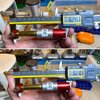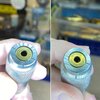denton
Member
I had a similar problem with a 30-30 bolt action. Possibly this will help....
My problem was an extra tight chamber. New brass fit just fine. But full length sizing would not size range brass small enough to fit. The brass would stick when the pressure ring tried to enter the chamber.
You can quickly find out if this is the problem, using a Sharpie and looking for places the marker is scraped off.
If this is the problem, let me know and I can suggest a possible solution.
My problem was an extra tight chamber. New brass fit just fine. But full length sizing would not size range brass small enough to fit. The brass would stick when the pressure ring tried to enter the chamber.
You can quickly find out if this is the problem, using a Sharpie and looking for places the marker is scraped off.
If this is the problem, let me know and I can suggest a possible solution.




